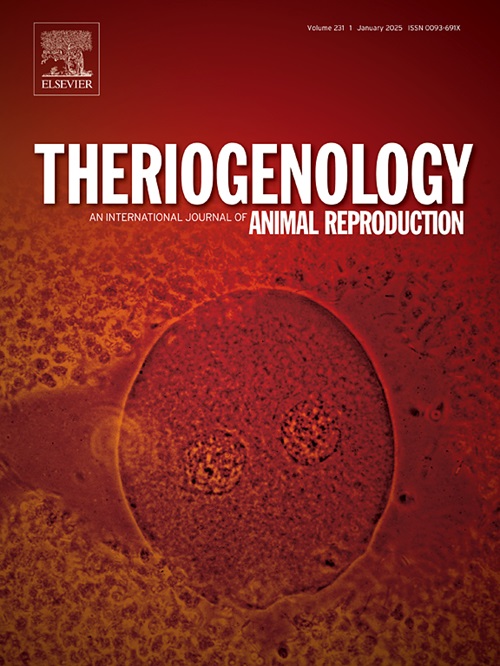利用阴道壁刺激诱导牛分娩的新方法
IF 2.4
2区 农林科学
Q3 REPRODUCTIVE BIOLOGY
引用次数: 0
摘要
牛的引产术在产犊管理中用于减少劳动,防止因牛犊过大而引起的难产,并治疗妊娠延长。传统的药物诱导方法依赖于前列腺素F2α (PGF2α)、地塞米松、雌激素和催产素(OXT),无论是单独的还是联合的。然而,诱导产犊时间(ICT)的变化,包括ICT的延长,仍然是一个主要挑战。在这项研究中,我们开发了一种新的方法,将传统的药物诱导与阴道壁刺激(VWS)相结合,人工激活Ferguson反射,增强内源性OXT分泌。我们比较了其对ICT、难产发生率和新生儿活力的影响,以评估这种新方法的有效性和安全性。对照组(每组15头)在预期产犊前1天分别给予PGF2α、地塞米松和雌三醇,VWS组在预期产犊后约24 h再给予相同的药物。与对照组相比,VWS组的ICT和ICT变异性均有统计学意义的降低。鉴于在VWS组中观察到的统计学上显著的劳动促进,ICT的这种改善可能归因于VWS的劳动诱导作用。此外,在产科干预率或新生儿小牛活力方面没有观察到显著差异。这种新方法可以促进更快速和一致的分娩,同时保持奶牛和新生牛犊的安全,并可能有助于提高产犊管理效率和减少牲畜生产者的工作量。本文章由计算机程序翻译,如有差异,请以英文原文为准。
A novel method for parturition induction in cattle using vaginal wall stimulation
Induction of parturition in cattle is used to reduce labor in calving management, prevent dystocia due to oversized calves, and treat prolonged gestation. Conventional pharmacological induction methods rely on prostaglandin F2α (PGF2α), dexamethasone, estrogens, and oxytocin (OXT), either individually or in combination. However, variability in the induction-to-calving time (ICT), including a prolonged ICT, remains a major challenge. In this study, we developed a novel method for inducing parturition by combining conventional pharmacological induction with vaginal wall stimulation (VWS), which artificially activates the Ferguson reflex and enhances endogenous OXT secretion. We compared its effects on the ICT, the incidence of dystocia, and neonatal vitality with those of pharmacological induction alone to evaluate the efficacy and safety of this new approach. Japanese Black breeding cows (n = 15 per group) in the control group received PGF2α, dexamethasone, and estriol 1 day before expected calving, while the VWS group received the same agents followed by VWS approximately 24 h later. Compared with the control group, the VWS group showed a statistically significant reduction in the ICT and decreased ICT variability. Given the statistically significant promotion of labor observed in the VWS group, this improvement in ICT may be attributable to the labor-inducing effect of VWS. Additionally, no significant differences were observed in obstetrical intervention rates or neonatal calf vitality. This novel approach may facilitate more rapid and consistent parturition while maintaining safety for both cows and newborn calves, and may contribute to improving calving management efficiency and reducing the workload of livestock producers.
求助全文
通过发布文献求助,成功后即可免费获取论文全文。
去求助
来源期刊

Theriogenology
农林科学-生殖生物学
CiteScore
5.50
自引率
14.30%
发文量
387
审稿时长
72 days
期刊介绍:
Theriogenology provides an international forum for researchers, clinicians, and industry professionals in animal reproductive biology. This acclaimed journal publishes articles on a wide range of topics in reproductive and developmental biology, of domestic mammal, avian, and aquatic species as well as wild species which are the object of veterinary care in research or conservation programs.
 求助内容:
求助内容: 应助结果提醒方式:
应助结果提醒方式:


